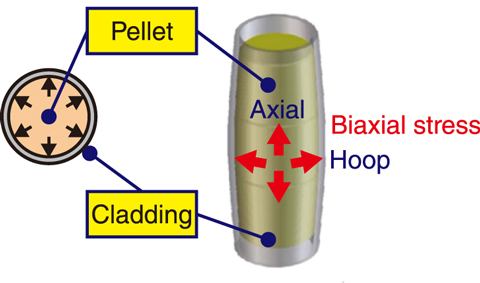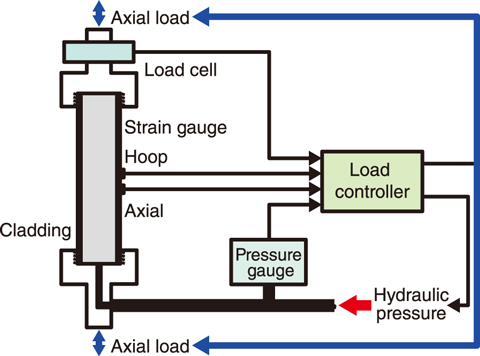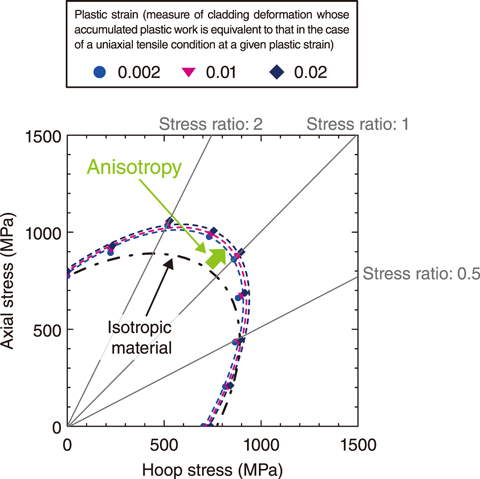
Fig.2-6 Anticipated stress state of nuclear fuel cladding during reactivity-initiated accidents (RIAs)

Fig.2-7 Biaxial tensile testing machine

Fig.2-8 Deformation anisotropy of Zircaloy-4 cladding
Reactivity-initiated accidents (RIAs) must be addressed during the safety design evaluation of light-water reactor facilities. In an RIA, a control rod ejection or drop triggers a fast rise in reactor power. Fuel pellets are then heated and thermally expanded, resulting in pellet–cladding mechanical interaction (PCMI), during which pellets rapidly push against the cladding (see Fig.2-6). This may lead to mechanical failure of the cladding. Since the safety of this event is based on the number of failed fuel rods, the reliability depends on the accuracy of the fuel failure limit adopted. Although the failure limit has been thought to be affected by the biaxial stress state, i.e., the simultaneous tensile forces in both the axial and hoop directions in the cladding, little systematic data acquired under mechanical conditions relevant to PCMI have been made available.
A biaxial tensile testing machine enabling precise control of the “stress ratio” (i.e., the ratio of axial stress to hoop stress) originally developed by Kuwabara et al.* was therefore modified and applied to a cladding specimen, as shown in Fig.2-7. The modification involved the design of a new jig to hold the tube specimen and a control program. Implementation allowed for data of Zircaloy-4 cladding deformation behavior to successfully be obtained for stress ratios from 0.5 to 1, which includes RIA conditions. The resulting relationship between the stress ratio and extended plastic deformation level is shown in Fig.2-8. Here, when compared with that of an isotropic material, the resulting ellipse extended to the upper-right with deformation (i.e., behaved anisotropically). Microscopic observation of the specimen by scanning electron microscopy revealed that this anisotropic behavior is a result of the combined effect of the intrinsic anisotropy of the Zr crystal with its hexagonal close-packed structure and the biased crystal orientations introduced in the fabrication process of the polycrystalline cladding. This study provided novel deformation anisotropy data of the PWR-type cladding, which led to a proposed mechanical property model describing plastic hardening behavior under biaxial stress conditions.
This developed model was then applied to computer simulations of PCMI failure performed by JAEA; the knowledge obtained by these simulations has been reflected in the new PCMI failure threshold which we have proposed recently to improve the reliability and rationality of safety regulations.
The study was conducted in FY2015, sponsored by the Nuclear Regulation Authority (NRA), Japan.
(Takeshi Mihara)
*Kuwabara, T. et al., Yield Locus and Work Hardening Behavior of a Thin-Walled Steel Tube Subjected to Combined Tension-Internal Pressure, Journal de Physique IV, vol.105, 2003, p.347–354.